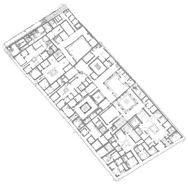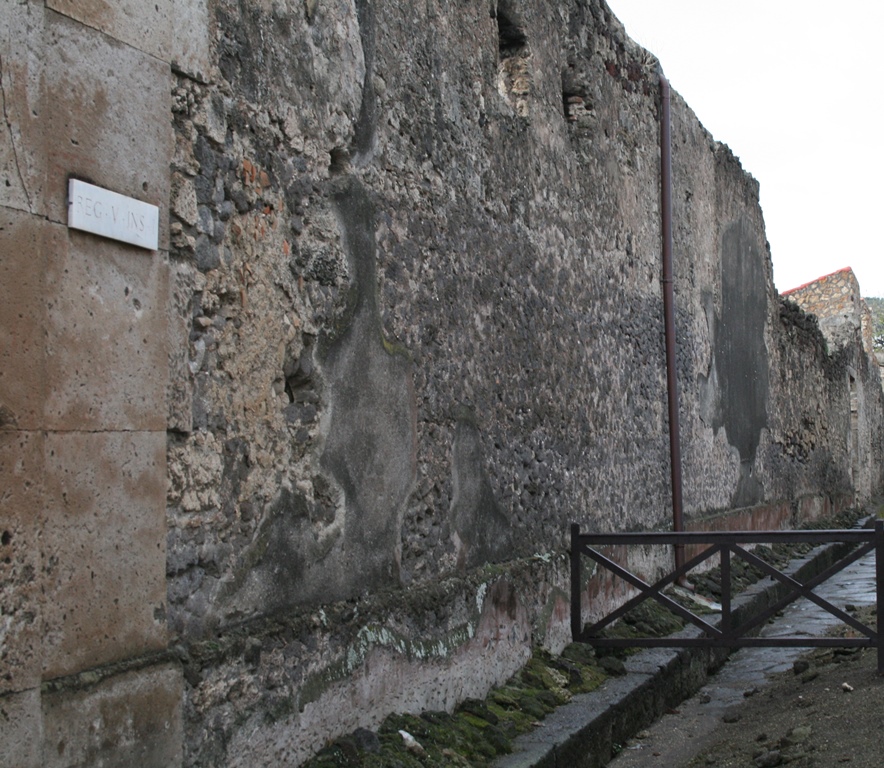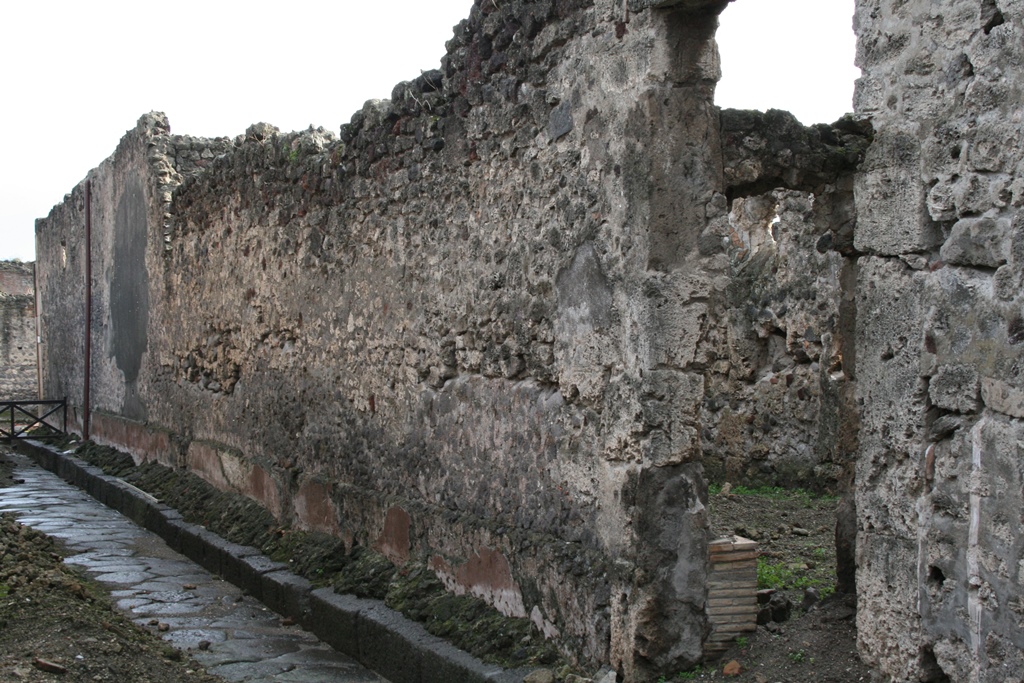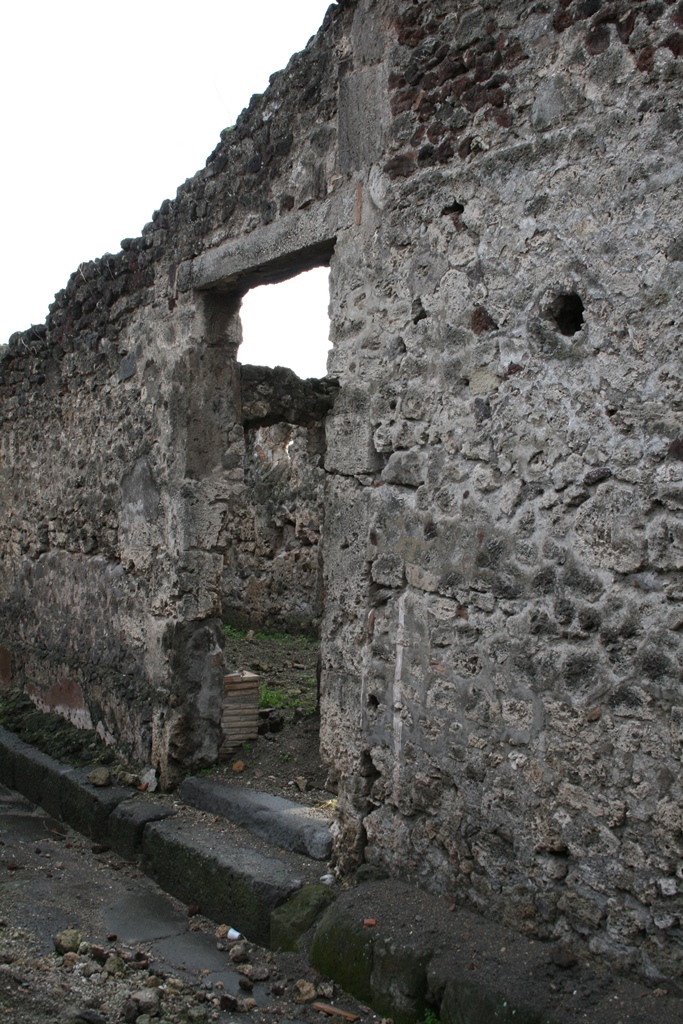External wall east side
Description
Thomas Staub
EAST FACADE
Width: 38.7 m, max. preserved h: 5.50 m (for the southern stripe of 0.20 m), thereafter degrading to a max. h of 3.90 m. The corner, interlocking with the facade towards Via di Nola, is erected in tuff blocks, h see above (south facade), on a foundation course. The lowest block in the wall protrudes for 0.04 m. The corner is once more accentuated by a pilaster, w: 0.45 m. The northern blocks of the third, the fifth and the seventh rows stretch into the opus incertum of the wall for 0.10 m. On the corner block, in 2.40 m h, unreadable remains of a graffito are still visible, partly covered by the modern marble plate giving the numbers for the insula.
All along the eastern facade, the lower part of the wall protrudes for about 0.08 - 0.10 m, not following the slope of the sidewalk, thus the h diminishes from 0.90 m in the southern part to 0.65 m in the northern part, next to posticum V 1,9. A red hydraulic plaster covers this zone of the wall. In a later phase, this surface was pecked for the application of new plaster. A slope (h: 0.40 m, w: max. 0.40 m) was erected in mixed rubble masonry in a yellowish mortar against this, thus taking up nearly the entire western sidewalk.
The first 16 m of the wall itself were constructed of opus incertum, up till a h of 3.00 m, mainly of lava rubble, in parts reinforced by laying Sarno limestone blocks (max. 0.60 x 0.20 m), all set into a reddish mortar. In the southernmost part, a yellowish mortar, into which ceramic sherds are pressed, covers an area of the wall (until 3.00 m from the S-E corner). Between 3.00 and 4.10 m from the S-E corner, parts of the wall are covered with plaster without any remains of colours, the same can be observed between 15.5 and 20.2 m from this corner. Here the plaster covering the upper parts of the wall is going over the course plaster of the protruding socle zone. Above the zone with lava rubble, the opus incertum consists mainly of Sarno limestone rubble, in parts also of lava and red cruma, all set into the reddish mortar. At 4.75 m, in 5.00 m h, there is a window opening (0.10 x 0.15 m, modern framing) from the upper floor of V 1,8. Again at 6.20 m, in 3.90 m h, a window opening (w: 0.80 m, h: 0.70 m, partly framed by Sarno stone blocks) from room 6 is visible, and at 8.50 m, in app. 3.90 m h, a window opening from cubiculum 7 (the frame is demolished, so that no measurements can be given). At 10.30 m, still in the same h, a blocked window can be observed (w: 0.70 m, h: 0.60 m), originally also from cubiculum 7. At 13.9 m, in 4.00 m h, a window opens up (w: 0.15 m, h: 0.25 m) from cubiculum 8, and at 21.9 m, in 3.10 m h; a window opening is placed (w: 0.30 m, h: 0.40 m) from room 11. At 20.5 m, in 3.30 m h, there is a 0.80 m high vertical row of blocks of Sarno stone (0.18 x 0.10 m).
To the N of the bigger plastered area of the wall, the lower parts are still erected in lava opus incertum, but the parts over 1.50 - 1.60 m h are built with a more mixed incertum (Sarno stone, lava and cruma), up to the h of 3.00 m in the reddish mortar, above probably a modern reconstruction. From 24.5 m, the wall is covered with modern concrete, in parts above 1.50 m h modern reconstructions. At 31.5 m, a hole (w: 0.30 m, h: 0.20 m) for a drainage sewer is hewn through the curb stone of the sidewalk. The sewer itself is made of terracotta pipes (diam. 0.09 m) and continues into the peristyle.
At 36.6 m, the posticum (V 1,9) opens towards room d. The door (w: 1.80 m, h: 2.55 m) is framed by Sarno stone standers and stretchers: southern jamb: four blocks from bottom to top: 1. w: 0.30 m x h: 1.10 m, 2. w: 0.50 m x h: 0.40 m, 3. w: 0.30 m x h: 0.35 m, 4. w: 0.30 m x h: 0.70 m, over the last block comes the modern lintel. To the S of this jamb, some plaster is preserved between 1.50 and 2.10 m h.
The northern jamb has a passage w of 0.40 m, since the layers all reach into the N wall of the house, thus not continuing across the border to V 1,26, Casa di Caecilius Iucundus. Thus, the prolongation of the E wall of the insula abuts against the pre-existing N wall of V 1,7. Heights of the blocks of the northern jamb: 0.50 m, 0.60 m, 0.90 m, 0.30 m, and then follows a modern part into witch the lintel is posed. Above the modern restorations (in app. 3.60 m h), the standers and stretchers continue: h: 0.50 m, 0.35 m (this block is only 0.25 m wide) and 0.30 m (reaching out for app. 0.20 m to the E).




